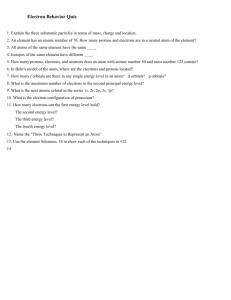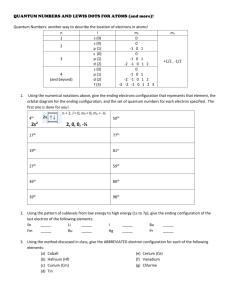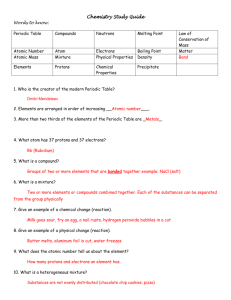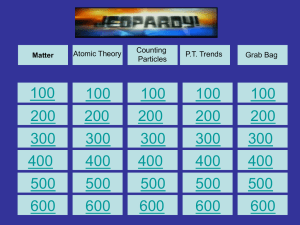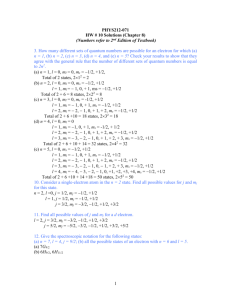Honors Chemistry: Atomic Theory Study Guide
advertisement
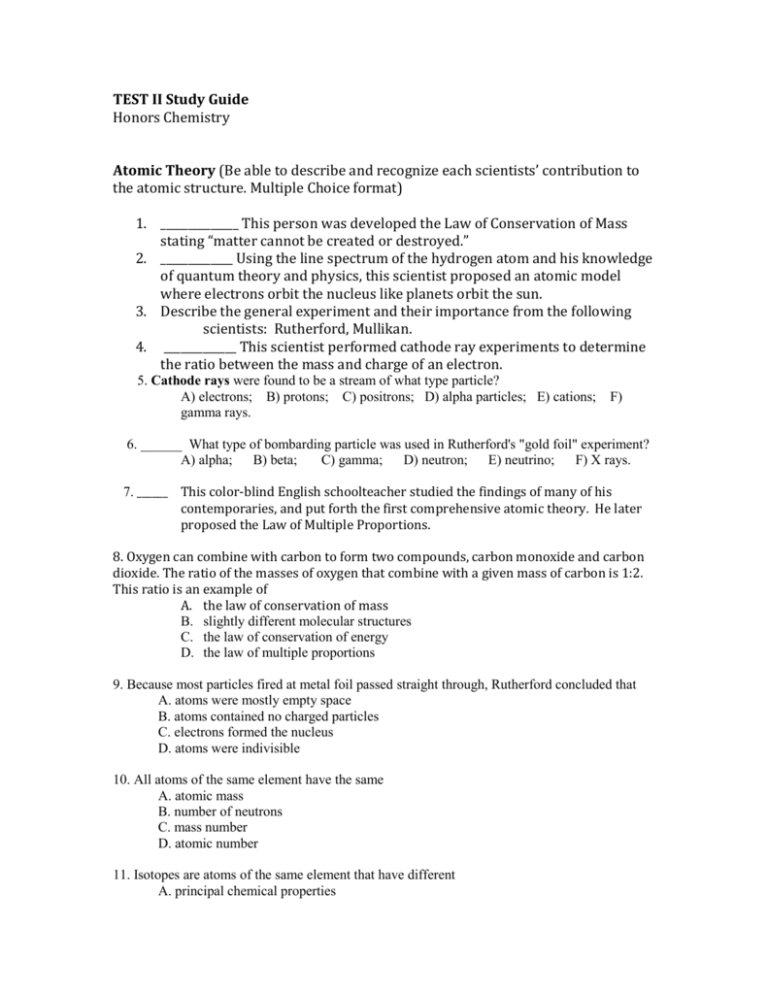
TEST II Study Guide Honors Chemistry Atomic Theory (Be able to describe and recognize each scientists’ contribution to the atomic structure. Multiple Choice format) 1. ______________ This person was developed the Law of Conservation of Mass stating “matter cannot be created or destroyed.” 2. _____________ Using the line spectrum of the hydrogen atom and his knowledge of quantum theory and physics, this scientist proposed an atomic model where electrons orbit the nucleus like planets orbit the sun. 3. Describe the general experiment and their importance from the following scientists: Rutherford, Mullikan. 4. _____________ This scientist performed cathode ray experiments to determine the ratio between the mass and charge of an electron. 5. Cathode rays were found to be a stream of what type particle? A) electrons; B) protons; C) positrons; D) alpha particles; E) cations; gamma rays. F) 6. ______ What type of bombarding particle was used in Rutherford's "gold foil" experiment? A) alpha; B) beta; C) gamma; D) neutron; E) neutrino; F) X rays. 7. ______ This color-blind English schoolteacher studied the findings of many of his contemporaries, and put forth the first comprehensive atomic theory. He later proposed the Law of Multiple Proportions. 8. Oxygen can combine with carbon to form two compounds, carbon monoxide and carbon dioxide. The ratio of the masses of oxygen that combine with a given mass of carbon is 1:2. This ratio is an example of A. the law of conservation of mass B. slightly different molecular structures C. the law of conservation of energy D. the law of multiple proportions 9. Because most particles fired at metal foil passed straight through, Rutherford concluded that A. atoms were mostly empty space B. atoms contained no charged particles C. electrons formed the nucleus D. atoms were indivisible 10. All atoms of the same element have the same A. atomic mass B. number of neutrons C. mass number D. atomic number 11. Isotopes are atoms of the same element that have different A. principal chemical properties B. masses C. numbers of protons D. numbers of electrons 12. An atom is electronically neutral because A. neutrons balance the protons and electrons B. nuclear forces stabilize the charges C. the numbers of protons and electrons are equal D. the numbers of protons and neutrons are equal 13. Chlorine has atomic number 17 and mass number 35. It has A. 17 protons, 17 electrons, and 18 neutrons B. 35 protons, 35 electrons, and 17 neutrons C. 17 protons, 17 electrons, and 52 neutrons D. 18 protons, 18 electrons, and 17 neutrons Electromagnetic Spectrum (Multiple Choice) ______ 1. This type of electromagnetic spectrum is unique to an element on the periodic table and can be used for the identification of the element. A) line spectrum B) broad spectrum C) continuous spectrum D) white spectrum ______ 2. For which of the following types of electromagnetic radiation would the photons have the GREATEST energy? A) microwaves B) X-rays C) IR D) visible E) UV ________3. Which of the following relationships is true? A. higher-frequency light has a longer wavelength than lower-frequency light B. higher-frequency light has a shorter wavelength than lower-frequency light C. higher-frequency light travels at a faster speed than lower-frequency light D. higher-frequency light has a lower energy than lower-frequency light does _______4. Selenium, Se, has the electron configuration [Ar]4s24p4. What is the highest energy level of an electron in Se? A. 2 B. 4 C. 5 D. 6 _______ 5. How many electrons total are in the atom with an electron configuration of [Ar] 4s23d104p1 ? A. 21 B. 31 C. 13 D. 11 _______ 6. The electron configuration [Kr]5s24d105p2 represents the location of electrons for the element A. Pb B. Sn C. Bi D. In E. None of the above PEN Method, Electron configuration, and orbital diagram for the following: (Problem and Multiple Choice format) 1) P 2) Li+1 3) K 4) S 5) N Short method of electron configuration with orbital diagrams. 1) I 2) Mo 3) Ca Quantum Theory/Electron Orbitals (be able to draw orbital diagram, and predict quantum numbers—multiple choice and problem format) Consider this complete electron configuration for the following neutral element: 2 2 6 2 6 2 10 1s 2s 2p 3s 3p 4s 3d 6 2 10 4p 5s 4d 6 2 14 10 5p 6s 4f 5d 5 6p 1._________ What is the highest energy subshell in this element? 2.._________ What is the chemical symbol for the element being described? 3. .________ What is the total number of subshells within this element? 4. The number of orbitals for the d sublevel is __________ A. 1 B. 3 C. 5 D. 7 5. What is the shape of an orbital when L =1 ? A. s, a sphere B. p, the shape of the dumbbell C. d, double dumbbell shape intersecting in the middle D. f, three d shapes intersecting in the middle 6. Which quantum number tells something about an electron’s distance from the nucleus? A. the principal quantum number or shell B. the angular momentum or subshell C. magnetic quantum number or orbital D. the spin quantum number or spin 7. An orbital where L = 3, can be oriented how many ways in space A. 0 B. 3 C. 5 D. 7 ______ 8. An orbital is best defined as A) an energy level for electrons B) a region in space in which there is a high probability of finding an electron C) a node where the probability of finding an electron is small D) an orientation of the nucleus and electron in an atom E) a circular path that an electron takes around a nucleus Average Atomic Mass 1) A gaseous element has two isotopes: G-102 with an atomic weight of 102.11 and G-108 with an atomic weight of 108.08. The percent abundance of the heavier isotope is 34.550%. What is the average atomic weight of element G? 2) Another element - Z - has three isotopes: Z-78 with a weight of 77.989, Z-81 with a weight of 81.000, and Z-82 with a weight of 82.003. The percent abudance of the three isotopes is: Z-78 34.050%, Z-81 50.720%, and Z-82 15.230%. What is the average atomic weight of element Z ? 3) The average atomic mass of an element is the average of the atomic masses of its A. naturally occurring isotopes B. two most abundant isotopes C. radioactive isotopes D. artificial isotopes 4) A certain metallic element has two stable isotopes: M-45 and M-48. Given that the atomic weights are 45.0010 and 48.0014, respectively, what is the percent abundance of the lighter isotope if the average atomic weight of M is 47.2002?

